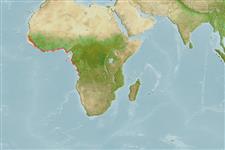>
Carangiformes (Jacks) >
Carangidae (Jacks and pompanos) > Caranginae
Etymology: Hemicaranx: Greek, hemi = the half + French, carangue, the name of a Caribbean fish; 1836 (Ref. 45335).
More on author: Günther.
Environment: milieu / climate zone / depth range / distribution range
Sinh thái học
Biển; Thuộc về nước lợ gần đáy. Tropical
Eastern Atlantic: Along the west African coast from Sierra Leone to Angola (Ref. 57392). Reported from the Sine-Saloum Estuary in Senegal, the Gambia River in Gambia, the Fatala River in Guinea (Ref. 28587) and from Mauritania (Ref. 55783), but this is unconfirmed in Ref. 57392 and needs confirmation.
Bộ gần gũi / Khối lượng (Trọng lượng) / Age
Maturity: Lm ? range ? - ? cm
Max length : 70.0 cm TL con đực/không giới tính; (Ref. 57392); common length : 25.0 cm FL con đực/không giới tính; (Ref. 3195)
Các tia vây lưng cứng (tổng cộng) : 8; Các vây lưng mềm (tổng cộng) : 24 - 28; Tia cứng vây hậu môn: 3; Tia mềm vây hậu môn: 21 - 24. Diagnosis: body elongate (depth comprised 2.4-3.1 times in fork length) and strongly compressed; eyes small; snout short and rounded; mouth small; end of upper jaw extending to below anterior eye margin; teeth present in jaws, absent on vomer; 1st dorsal fin with 7 spines, 2nd dorsal with 1 spine and 24-28 soft rays; anal fin with 2 detached spines, followed by 1 spine and 21-24 soft rays; scales small and cycloid; breast completely scaleless; lateral line arched over anterior half of pectoral fins, its posterior (straight) part with 41-43 scutes; caudal peduncle very slender, without bilateral keels above and below last lateral line scutes (Ref. 57392).
Coloration: back bluish, sides silvery; black spot on upper margin of gill cover; dorsal- and upper caudal-fin lobes broadly black-edged, other fins light; juveniles with 4-5 dark crossbars on back and sides (Ref. 57392).
Adults are found mainly in coastal areas, entering brackish water (Ref. 2683, 57392). Common mostly in midwater and near bottom (Ref. 7079). Young live in association with medusa (jellyfish) (Ref. 57392).
Life cycle and mating behavior
Chín muồi sinh dục | Sự tái sinh sản | Đẻ trứng | Các trứng | Sự sinh sản | Ấu trùng
Smith-Vaniz, W.F., J.-C. Quéro and M. Desoutter, 1990. Carangidae. p. 729-755. In J.C. Quero, J.C. Hureau, C. Karrer, A. Post and L. Saldanha (eds.) Check-list of the fishes of the eastern tropical Atlantic (CLOFETA). JNICT, Lisbon; SEI, Paris; and UNESCO, Paris. Vol. 2. (Ref. 7097)
IUCN Red List Status (Ref. 130435: Version 2024-2)
Threat to humans
Harmless
Human uses
Các nghề cá: buôn bán nhỏ
Các công cụ
Special reports
Download XML
Các nguồn internet
Estimates based on models
Preferred temperature (Ref.
123201): 24.4 - 27.9, mean 26.7 °C (based on 62 cells).
Phylogenetic diversity index (Ref.
82804): PD
50 = 0.5625 [Uniqueness, from 0.5 = low to 2.0 = high].
Bayesian length-weight: a=0.01445 (0.00841 - 0.02484), b=2.92 (2.78 - 3.06), in cm total length, based on LWR estimates for this species & (Sub)family-body (Ref.
93245).
Mức dinh dưỡng (Ref.
69278): 3.9 ±0.6 se; based on size and trophs of closest relatives
Thích nghi nhanh (Ref.
120179): Trung bình, thời gian nhân đôi của chủng quần tối thiểu là 1.4 - 4.4 năm (Preliminary K or Fecundity.).
Fishing Vulnerability (Ref.
59153): Moderate to high vulnerability (48 of 100).
Nutrients (Ref.
124155): Calcium = 115 [78, 276] mg/100g; Iron = 1.24 [0.76, 2.35] mg/100g; Protein = 19.3 [18.3, 20.5] %; Omega3 = 0.248 [0.146, 0.435] g/100g; Selenium = 53.5 [29.9, 100.0] μg/100g; VitaminA = 13.3 [4.2, 32.3] μg/100g; Zinc = 1.06 [0.78, 1.46] mg/100g (wet weight);
